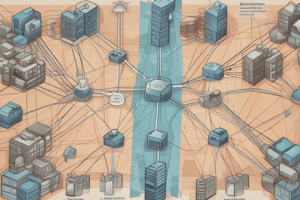Podcast
Questions and Answers
Manakah yang merupakan standar LAN nirkabel utama yang digunakan untuk koneksi tanpa kabel?
Manakah yang merupakan standar LAN nirkabel utama yang digunakan untuk koneksi tanpa kabel?
- Ethernet
- TCP/IP
- Blockchain
- Wi-Fi (correct)
Apa yang dimaksud dengan keutuhan data dalam konteks keamanan jaringan?
Apa yang dimaksud dengan keutuhan data dalam konteks keamanan jaringan?
- Memastikan bahwa data hanya dapat diakses oleh individu yang berwenang dan tidak disadap oleh pihak yang tidak berwenang
- Mempertahankan akurasi dan konsistensi data untuk mencegah pemalsuan dan perubahan yang tidak diizinkan (correct)
- Memastikan bahwa data dan sumber daya jaringan dapat diakses oleh pengguna yang berwenang sepanjang waktu
- Mengenkripsi data untuk mencegah dibacanya oleh pihak yang tidak berwenang
Apa teknologi yang membawa kecerdasan buatan (AI) ke dalam pengelolaan, optimisasi, dan keamanan jaringan?
Apa teknologi yang membawa kecerdasan buatan (AI) ke dalam pengelolaan, optimisasi, dan keamanan jaringan?
- Edge Computing
- Internet of Things (IoT)
- 5G
- Blockchain (correct)
Manakah yang merupakan langkah umum keamanan jaringan untuk mencegah akses yang tidak sah ke sumber daya jaringan dan data?
Manakah yang merupakan langkah umum keamanan jaringan untuk mencegah akses yang tidak sah ke sumber daya jaringan dan data?
Apa yang dimaksud dengan topologi jaringan di mana perangkat terhubung oleh rute-rute multiple sehingga memberikan redundansi dan transmisi data yang efisien?
Apa yang dimaksud dengan topologi jaringan di mana perangkat terhubung oleh rute-rute multiple sehingga memberikan redundansi dan transmisi data yang efisien?
Study Notes
Exploring the Basics of Computer Networking and Telecommunications
In today's interconnected world, understanding the fundamental principles of computer networking and telecommunications is crucial. Whether you're a student, a professional, or simply someone with a curiosity for how the digital world works, diving into this subject will help you grasp the foundations that enable communication and information exchange across the globe.
Telecommunication Technologies
Telecommunication technologies form the backbone of information transmission over vast distances. They are the physical and logical means by which data is exchanged between devices.
- Wired Technologies: These involve the use of cables to transmit electrical signals, such as Ethernet and coaxial cable.
- Wireless Technologies: These employ radio waves to convey data, including Wi-Fi, Bluetooth, and cellular networks.
- Satellite Technologies: These enable communication over large geographical areas, such as satellite internet and satellite TV.
Networking Topologies and Protocols
Computer networks are organized in various topologies, each with its own set of advantages and disadvantages. Some common topologies include:
- Bus Topology: A single cable with multiple devices connected to it, sharing the data.
- Star Topology: Devices connected to a central hub or switch, with each device having a dedicated link to the central point.
- Ring Topology: Devices connected in a closed loop, passing data from one device to another.
- Mesh Topology: Devices connected by multiple routes, providing redundancy and efficient data transmission.
Networking protocols define the rules and standards for data exchange between devices. Some important protocols include:
- TCP/IP: The de facto standard for internet communication and the basis for the World Wide Web.
- Ethernet: The most common local area network (LAN) standard, used for wired connections.
- Wi-Fi: The primary wireless LAN standard, used for wireless connections.
Network Security
Security is a vital concern in the realm of computer networking. Hackers and malicious actors are constantly seeking to exploit vulnerabilities to compromise the confidentiality, integrity, and availability of data.
- Confidentiality: Ensuring that data is only accessible to authorized individuals and not intercepted by unauthorized parties.
- Integrity: Preserving the accuracy and consistency of data to prevent tampering and unauthorized changes.
- Availability: Ensuring that data and network resources are accessible to authorized users at all times.
Some common network security measures include:
- Access Controls: Limiting access to data and network resources to authorized individuals.
- Encryption: Encoding data to prevent it from being read by unauthorized parties.
- Firewalls: Creating a barrier between internal and external networks to block unauthorized traffic.
- Intrusion Detection and Prevention Systems (IDPS): Detecting and preventing unauthorized access to network and data resources.
- Virtual Private Networks (VPNs): Creating a secure tunnel to transmit data between remote locations.
The Future of Computer Networking and Telecommunications
As technology continues to evolve, so do computer networking and telecommunications. Emerging trends in this field include:
- 5G: The fifth generation of cellular networks, providing faster data transfer speeds and lower latency.
- Internet of Things (IoT): The network of interconnected devices used to gather and exchange data.
- Artificial Intelligence (AI): Enhancing network security, optimization, and management by leveraging AI algorithms.
- Edge Computing: Bringing computing power closer to the data sources to improve performance and reduce latency.
- Blockchain: Securing data transmission and protecting the integrity of networked systems through decentralized consensus mechanisms.
Understanding the foundations of computer networking and telecommunications is an essential stepping stone toward grasping the complexities of the digital world. By mastering these fundamentals, you will be equipped to make informed decisions, anticipate technological trends, and contribute to the ongoing evolution of our connected society.
Studying That Suits You
Use AI to generate personalized quizzes and flashcards to suit your learning preferences.
Description
Menjelajahi prinsip-prinsip dasar jaringan komputer dan telekomunikasi yang menjadi tulang punggung pertukaran informasi di seluruh dunia. Pelajari teknologi telekomunikasi, topologi jaringan, protokol, keamanan jaringan, dan tren masa depan dalam bidang ini.




